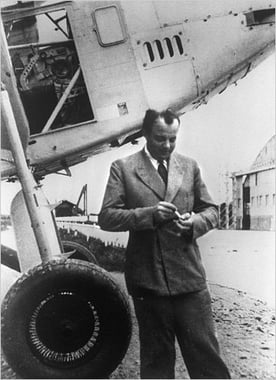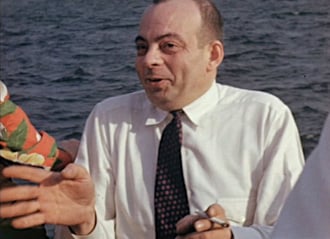The Little Prince (1943) is one of the most popular children's books (or books of any kind, really) of all time. Combined, its child-centric worldview and its surprisingly subtle psychological and philosophical observations have led to decades of adoration and constant re-rereading from children and adults alike—all of this is quite remarkable given the fact that the book's author, French aviator and writer Antoine de Saint-Exupéry, was neither a children’s book author nor an illustrator of any standing. In fact, Saint-Exupéry began writing the book only at the suggestion of his publisher’s wife, who believed that the project might calm his nerves. After all, the man had hardly led a tranquil life.
 Saint-Exupéry was born to a reasonably well-off family in Lyon, France in 1900. After dropping out of both the Naval Academy and the École des Beaux-Arts, he discovered what would become a lifelong passion: flying. He quickly became a noted airmail pilot, conveying mail across several continents, exploring new flight paths, and once negotiating a hostage release in the Saharan desert (for which he would receive his first Légion d'honneur) in the years leading up to World War II.
Saint-Exupéry was born to a reasonably well-off family in Lyon, France in 1900. After dropping out of both the Naval Academy and the École des Beaux-Arts, he discovered what would become a lifelong passion: flying. He quickly became a noted airmail pilot, conveying mail across several continents, exploring new flight paths, and once negotiating a hostage release in the Saharan desert (for which he would receive his first Légion d'honneur) in the years leading up to World War II.
When the war broke out, he flew for the French military until the Nazi occupation of France began, whereupon he fled to North America. There, he advocated for America’s swift entry into the war (reputedly while having an affair with Charles’s Lindbergh’s wife, Anne Morrow Lindbergh, who was advocating for the exact opposite course of action). When the Americans did join the war, Saint-Exupéry convinced the American forces to let him fly reconnaissance missions, despite being, at age 43, much older than the maximum age limit.
The impact of his aviation career on his work as a writer, even before he wrote The Little Prince, would prove to immeasurable. Despite his inability to finish a course of study, he was always a fairly literary-minded individual, and he was known to read and write in his one-seat aircraft, often jotting down ideas in his notebook mid-flight. His first two books, The Aviator (1926) and Southern Mail (1929), were based on his experience as a pilot. Later, he would win a National Book Award for non-fiction for Wind, Sand and Stars (1939), in which he described his time spent traveling dangerous mail-carrying routes across the Sahara and the Andes.
 The central anecdote in Wind, Sand, and Stars is by far its most harrowing. It details an attempt to break the speed record flying from Paris to Saigon, during which Saint-Exupéry and his navigator crashed in the Sahara Desert. After miraculously surviving the crash, the pair found themselves stranded with only one day’s worth of water and no way of determining their exact location. Both came close to dying of dehydration, experiencing visual and auditory hallucinations in the process, before being miraculously saved by a passing Bedouin. While this episode made for great literary fodder in its own right, fans of The Little Prince will recognize the impact this episode had on the composition of the children’s book. The narrator of the tale is, after all, a downed pilot trying to survive in the Sahara Desert.
The central anecdote in Wind, Sand, and Stars is by far its most harrowing. It details an attempt to break the speed record flying from Paris to Saigon, during which Saint-Exupéry and his navigator crashed in the Sahara Desert. After miraculously surviving the crash, the pair found themselves stranded with only one day’s worth of water and no way of determining their exact location. Both came close to dying of dehydration, experiencing visual and auditory hallucinations in the process, before being miraculously saved by a passing Bedouin. While this episode made for great literary fodder in its own right, fans of The Little Prince will recognize the impact this episode had on the composition of the children’s book. The narrator of the tale is, after all, a downed pilot trying to survive in the Sahara Desert.
During the war, Saint-Exupéry’s legacy was in a slightly precarious position. While the Vichy government had banned certain of his books for negative mentions of Hitler and for praising Jewish aviators with whom he had worked, Saint-Exupéry was a fierce critic of Free French general Charles de Gaulle. As a result, de Gaulle tried to paint the author and aviator as a Nazi sympathizer, earning his books the strange distinction of being banned in both collaborationist territory and among the resistance as well. Since his death in 1944 (evidently following a plane crash experienced during one of his reconnaissance missions for the Americans), however, his work as both a writer and an aviator has been held in the highest esteem, with The Little Prince becoming one of the most-translated, most-adapted, most-read, and most beloved children’s books in history, appearing along with its author on the French fifty-franc note.









